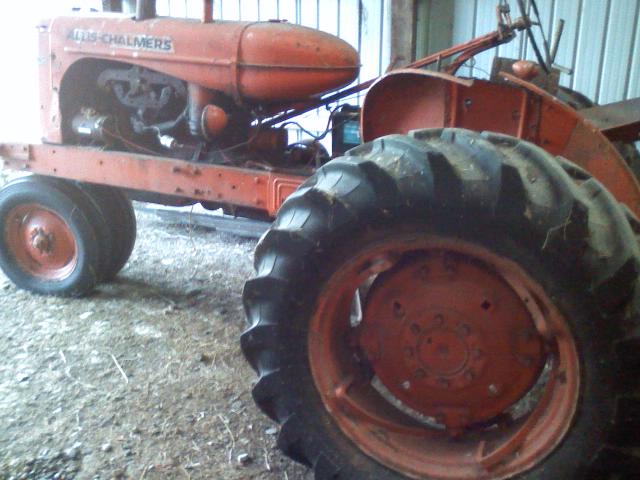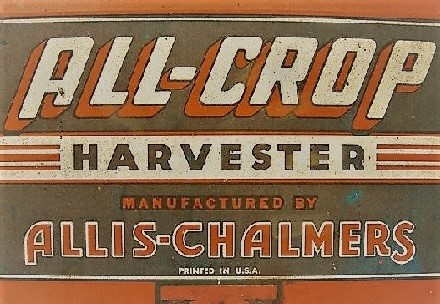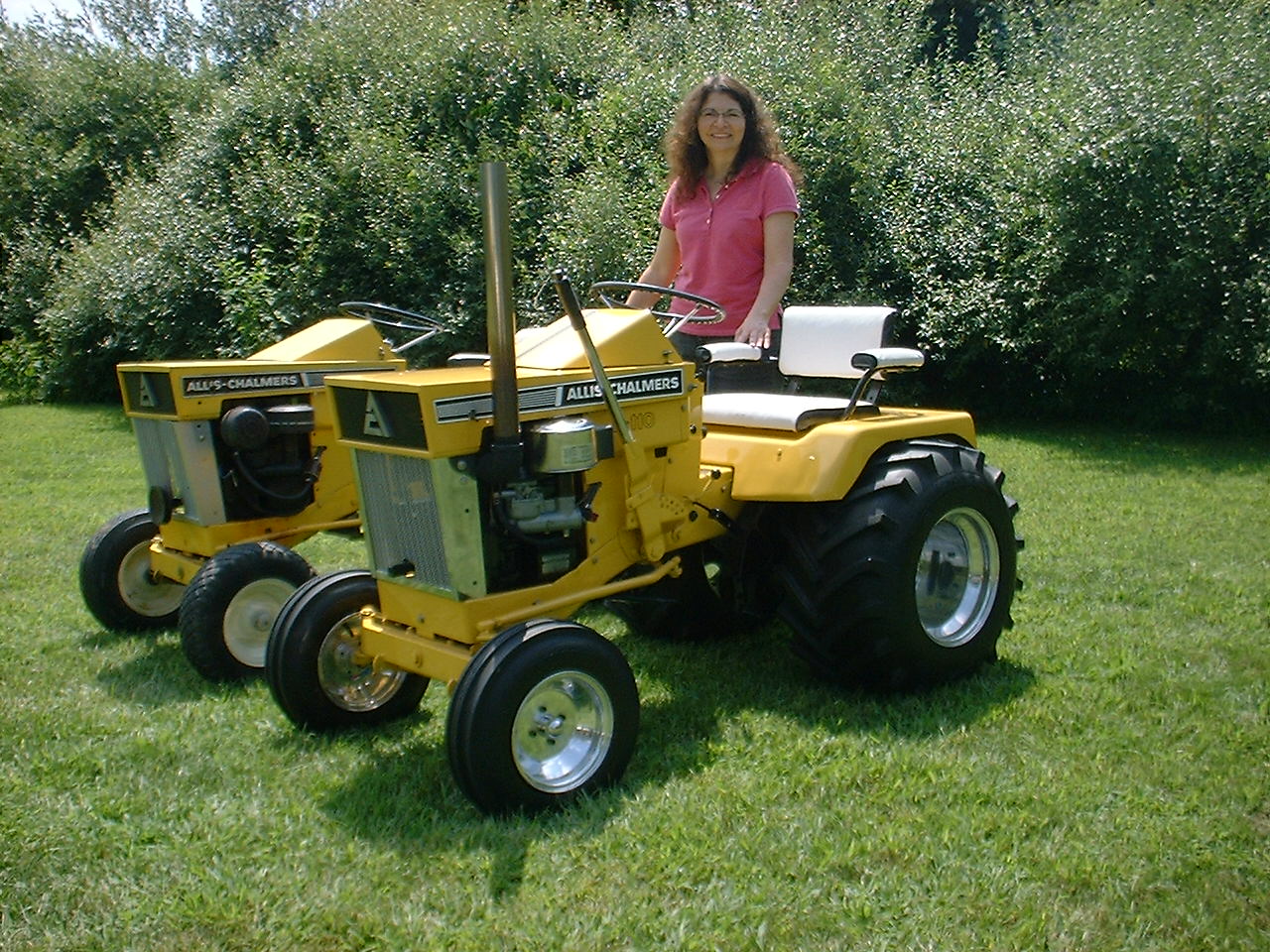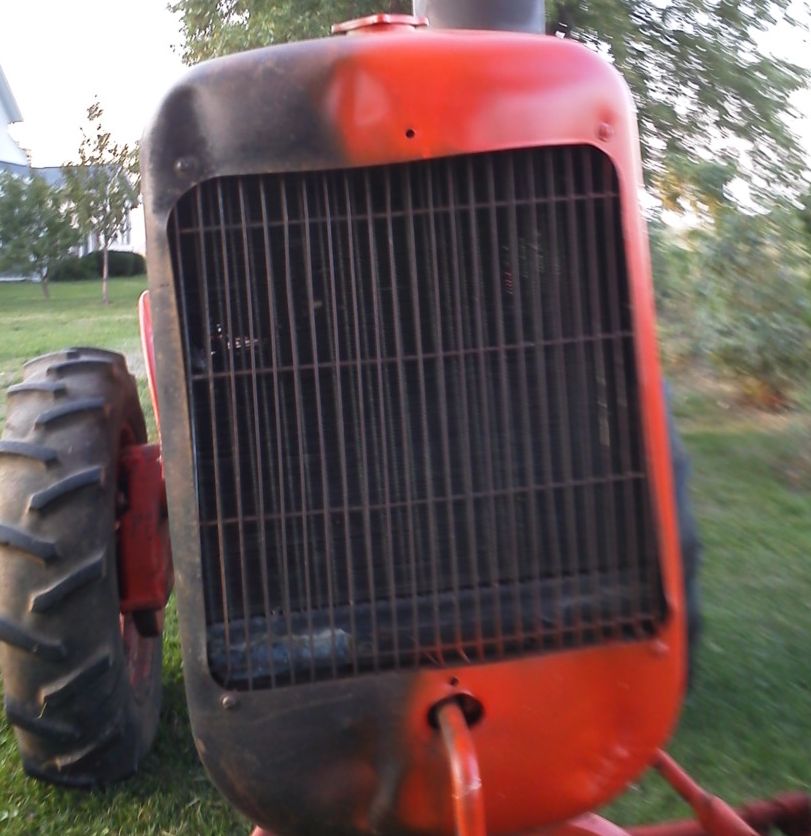| Author |
 Topic Search Topic Search  Topic Options Topic Options
|
skeeters65 
Orange Level

Joined: 09 Jul 2015
Location: CT
Points: 371
|
 Post Options Post Options
 Thanks(0) Thanks(0)
 Quote Quote  Reply Reply
 Topic: Converting B to 12volt Topic: Converting B to 12volt
Posted: 07 Oct 2015 at 7:32pm |
|
I have a 1950 B that is positive ground 6 volt. (Makes zero sense to me)
Are ther any advantages to converting over to 12 volt?
Seems like it would be expensive.
Thanks
|
 |
|
Sponsored Links
|
|
 |
Sugarmaker 
Orange Level


Joined: 12 Jul 2013
Location: Albion PA
Points: 8627
|
 Post Options Post Options
 Thanks(0) Thanks(0)
 Quote Quote  Reply Reply
 Posted: 07 Oct 2015 at 8:25pm Posted: 07 Oct 2015 at 8:25pm |
|
Battery, Alternator, brackets, wiring, switches, lights, my est would be $250 and if you have any money left take the wife out for lunch. The feeling when the tractor kicks in and starts and charges = PRICELESS!
I have not regretted changing the three WD's to 12 volt. Yea its not original, but I still work them a little and I want them to start for the kids and grandkids!
Regards,
Chris
|
|
D17 1958 (NFE), WD45 1954 (NFE), WD 1952 (NFE), WD 1950 (WFE), Allis F-40 forklift, Allis CA, Allis D14, Ford Jubilee, Many IH Cub Cadets, 32 Ford Dump, 65 Comet.
|
 |
CrestonM 
Orange Level


Joined: 08 Sep 2014
Location: Oklahoma
Points: 8459
|
 Post Options Post Options
 Thanks(0) Thanks(0)
 Quote Quote  Reply Reply
 Posted: 07 Oct 2015 at 8:27pm Posted: 07 Oct 2015 at 8:27pm |
This is almost like a politics discussion... I prefer 6V. These tractors were designed with them and have run fine like that for 60+ years. I see no problem with it. Some guys who like 12V say they start easier. All a 12V system does is spin it faster. It'll also give you brighter lights, and that's a plus, but to me 6V lights are fine. In the end, it's just personal preference. My 2 cents.
|
 |
Bill Long 
Orange Level

Joined: 12 Sep 2009
Location: Bel Air, MD
Points: 4556
|
 Post Options Post Options
 Thanks(0) Thanks(0)
 Quote Quote  Reply Reply
 Posted: 07 Oct 2015 at 8:43pm Posted: 07 Oct 2015 at 8:43pm |
|
For prices call SteveNJ he is our resident electrical expert and can guide you with costs and options that make sense.
Take good care of my favorite.
Good Luck!
Bill Long
|
 |
DougS 
Orange Level


Joined: 03 Nov 2011
Location: Iowa
Points: 2490
|
 Post Options Post Options
 Thanks(0) Thanks(0)
 Quote Quote  Reply Reply
 Posted: 07 Oct 2015 at 8:45pm Posted: 07 Oct 2015 at 8:45pm |
|
Depends on how much you can do yourself. A 12 volt battery would be cheaper than a 6 volt battery if you switched at battery replacement time. A used alternator can be had at a junk yard for less than $50. Don't buy a Delco 10SI. It will be too big. A smaller Japanese 30 amp alternator would be plenty. 12 volt lights wouldn't be all that bad if you bought off the shelf assemblies. You may or may not need some wire. Brackets depend on if you can doing it yourself. Steve may have them. Sugar's price isn't far off if you have someone else do it. Do it yourself and you'll save a bunch.
|
 |
jaybmiller 
Orange Level Access

Joined: 12 Sep 2009
Location: Greensville,Ont
Points: 24890
|
 Post Options Post Options
 Thanks(0) Thanks(0)
 Quote Quote  Reply Reply
 Posted: 07 Oct 2015 at 8:46pm Posted: 07 Oct 2015 at 8:46pm |
|
A big benefit of going 12 volt,is being able to add a cheap 12V 'ATV' electric winch on the tractor.Maybe to raise a plow,pull a log out,lift a busted implement, ??
Another is being able to either get a 'jump start' or provide one as you're now 12 volt, negative ground like most of the World these days.
And...you can add a LOT of LED lights if you want...
As for cost..I've redone 4 D-14s and never spent a cent. Alternators are free(from scrap cars),12V battery is cheaper than a 6V up here,and my garage has lots of steel for brackets and 12V lights from other 'things'.
Jay
|
|
3 D-14s,A-C forklift, B-112
Kubota BX23S lil' TOOT( The Other Orange Tractor)
Never burn your bridges, unless you can walk on water
|
 |
Chalmersbob 
Orange Level

Joined: 11 Sep 2009
Location: Pennsylvania
Points: 2122
|
 Post Options Post Options
 Thanks(0) Thanks(0)
 Quote Quote  Reply Reply
 Posted: 07 Oct 2015 at 9:30pm Posted: 07 Oct 2015 at 9:30pm |
I'm in favor of keeping it 6 volts. If all the grounds are clean 6 volts will spin the engine fine. I just started a C that hasn't run in 8 years and after cleaning the ground contacts and removing the started to clean the mating surfaces my 8 year old 6 volt battery turn it over as fast as is needed. No need to change to alternator or change light bulbs. I'm in favor of keeping my tractors as original as possible. I even dissembled 2 amp meters this week and got the working because the are original AC meters. LOL Bob
|
|
4 B's, 1 C's,3 CA's, 2 G's WD, D14, D15, B-1, B10, B12, 712S,
|
 |
Gerald J. 
Orange Level

Joined: 12 Sep 2009
Location: Hamilton Co, IA
Points: 5636
|
 Post Options Post Options
 Thanks(0) Thanks(0)
 Quote Quote  Reply Reply
 Posted: 07 Oct 2015 at 9:53pm Posted: 07 Oct 2015 at 9:53pm |
|
In the old days 6 volt batteries were cheaper to make than 12 volt because of a simpler container and fewer intercell connections.
6 volt lamps have fatter filaments that stand up to shock and vibration better than higher voltage lamps, and tend to be slightly more efficient because the filament can operate at a higher temperature without evaporating enough tungsten to die rapidly.
Until the mid or late 50s, 6 volt battery systems were standard on cars, trucks, and tractors supported by a SAE standard. The standard didn't specify polarity. Indeed the deciding engineers from different companies had different opinions on the proper polarity, so both were used in these products.
As lighting and other electrical loads increased 6 volts showed a disadvantage of requiring twice the current for the same power, hence twice the copper wire cross section. And so more costly. Also switches needed to be rated for twice the current of 12 volts. In the early 60s (best I recall, I did dig out historical SAE standards to tell the year) SAE suggested 12 volts was better for new designs but allowed other voltages and suggested negative ground but didn't require it. A few years later the standard changed to require 12 volts negative ground unless there was no way to get enough power for starting at lower than 24 volts.
Part of the requirement of negative ground came with transistor radios. A vacuum tube radio (including two way) was not damaged with reversed polarity, it just didn't work. Many two ways were fitted with a vibrator to make and rectify the AC for the high voltage supply and there was a 6 pin vibrator that could be rotated 180 degrees in the socket to change the rectified polarity. A transistor radio on the other hand generally converts all transistors to dead shorts of melted germanium or silicon in the first milliseconds of reversed polarity power. Far quicker than it takes to blow a fuse. So with a transistor radio the blown fuse is only an indication of a failed transistor.
Today there are very few 6 volt batteries to choose from and they likely have sat on the store shelf for many months which is not good for them. There are many 12 volt batteries to choose from and its not hard to get one made recently for better operational life.
The polarity arguments in the 30s seemed to have their basis in polarity arguments from trolleys. With grounded rails all the way to the power plant there still is considerable earth current. When electrons go from the earth to a buried water pipe the pipe is preserved. Where the electrons leave the pipe, the pipe is eroded. So the proximity of water pipes to the trolley line and power plant determine which polarity will give the longest pipe lifetime. Engineers applied that to frame ground connections. To me that was erroneous because for every frame ground carrying current in one direction there was another carrying current in the opposite direction so if there's going to be selective corrosion, half the connections will corrode and the other half won't.
Today 12 volts negative ground is the SAE standard and confuses few operators so is safest. Fact is either polarity works equally well, and 12 volts barely works better than 6 volts though a 6 volt system needs attention twice a year cleaning battery posts and connectors and a 12 volt system can go a couple years between that maintenance just because the higher voltage tolerates more voltage drop and the current for a given power at 12 volts is half that at 6 volts.
Gerald J.
|
 |
Rich-MN 
Orange Level Access

Joined: 12 Sep 2009
Location: Ramsey,MN
Points: 3887
|
 Post Options Post Options
 Thanks(0) Thanks(0)
 Quote Quote  Reply Reply
 Posted: 07 Oct 2015 at 10:00pm Posted: 07 Oct 2015 at 10:00pm |
|
Besides changing the generator to an alternator and the grounding strap to (-) and 12v lights, what other items have to be added or deleted?
|
 |
DougS 
Orange Level


Joined: 03 Nov 2011
Location: Iowa
Points: 2490
|
 Post Options Post Options
 Thanks(0) Thanks(0)
 Quote Quote  Reply Reply
 Posted: 07 Oct 2015 at 10:10pm Posted: 07 Oct 2015 at 10:10pm |
 Rich-MN wrote: Rich-MN wrote:
Besides changing the generator to an alternator and the grounding strap to (-) and 12v lights, what other items have to be added or deleted? |
Nothing, if you are using a magneto. If you're using battery ignition you need either a ballast resistor for your coil or you need a 12 volt coil.
|
 |
MrHDC 
Orange Level


Joined: 14 Mar 2015
Location: Wichita, KS
Points: 254
|
 Post Options Post Options
 Thanks(0) Thanks(0)
 Quote Quote  Reply Reply
 Posted: 07 Oct 2015 at 11:23pm Posted: 07 Oct 2015 at 11:23pm |
|
If my CA 6v system had been intact and somewhat serviceable I would have left it as is. I have zero regrets though changing over to 12v. I love the 12v lights and will not miss having to resort to the hand crank like I did as a kid. Folks have definite opinions on 6v vs 12v and I won't begin to say which is better. For me and what I plan to do with the tractor 12v was the way to go. I plan on adding an inverter so I can run some small tools and even charge my cell phone. The cell phone part makes the wife happy. That way she can call and let me know it's time to come in from playing...
Hervey
|
 |
Steve in NJ 
Orange Level Access


Joined: 12 Sep 2009
Location: Andover, NJ
Points: 12044
|
 Post Options Post Options
 Thanks(0) Thanks(0)
 Quote Quote  Reply Reply
 Posted: 08 Oct 2015 at 5:32am Posted: 08 Oct 2015 at 5:32am |
|
We get a lot of calls about 6V vs 12V. I always ask our customer's (or potential customer's) what exactly are you going to do with the Tractor? We offer 6V wiring systems as well as a 12V conversion kit. If you just plan to restore the Tractor, use it in parades, and maybe do some lawn mowin' and things around the property, then the 6V should work fine. My B is still 6V, and it has a loader on it which I use quite often. I don't need the headlights much. Once in a while I'll use the Tractor in the evening hours. If your going to use the Tractor often, work a lot in the evening hours where more light is needed, and maybe add some accessories like Hervey did, then 12V would be your better option. It just greatly depends on your usage and whether you need that Tractor very reliable when you have to jump on it and GO. There are a lot of advantages moving to 12V's, but again, its up to the individual which way they want to go. If you pay a visit to our website, you can get a lot of information there, and look at our 12V conversions in "kit" form...
Steve@B&B
bb-customcircuits.com
|
|
39'RC, 43'WC, 48'B, 49'G, 50'WF, 65 Big 10, 67'B-110, 75'716H, 2-620's, & a Motorhead wife
|
 |
Johnwilson_osf 
Orange Level

Joined: 29 Jul 2012
Location: Mount Bethel PA
Points: 944
|
 Post Options Post Options
 Thanks(0) Thanks(0)
 Quote Quote  Reply Reply
 Posted: 08 Oct 2015 at 5:46am Posted: 08 Oct 2015 at 5:46am |
This is what I love about this site. We all have opinions, and can say one option or the other. But what this site has is guys who do things for a living, and can provide background. Reading Gerald's post, I learned a lot about voltage system history. Trolley cars may not be what I use regularly, but wow, things make sense when you think about how the technology developed. And Steve is right on. It depends upon the customer and what they want to do. I got my wiring harness from him, and haven't looked back. Well, except to see things with the awesome rear light I now have.
|
|
Allis Express: Eastern PA on Rt 80
8050, 8010, 6080, 190, D14, DA 6035, AA 6690, 5650, Gleaner F2
|
 |
skeeters65 
Orange Level

Joined: 09 Jul 2015
Location: CT
Points: 371
|
 Post Options Post Options
 Thanks(0) Thanks(0)
 Quote Quote  Reply Reply
 Posted: 08 Oct 2015 at 7:10am Posted: 08 Oct 2015 at 7:10am |
|
Would I need to replace my starter if I converted to 12v?
What about the distributor and coil?
Thanks
|
 |
Gerald J. 
Orange Level

Joined: 12 Sep 2009
Location: Hamilton Co, IA
Points: 5636
|
 Post Options Post Options
 Thanks(0) Thanks(0)
 Quote Quote  Reply Reply
 Posted: 08 Oct 2015 at 7:18am Posted: 08 Oct 2015 at 7:18am |
|
6 volt starters run fine and fast on 12 volts. I've read of the impulse mechanism in some magnetos may not work because of the fast cranking and that makes for hard starting. Some of the fast cranking could be slowed by wimpy (wallyworld kiosk) battery cables. They need to be changed anyway when changing the polarity if the positive ground cable is a bare braided strap. The posts are fat and skinny to hint at polarity.
Steve in N.J. does offer conversions of 6 volt starters.
Distributor is fine, coil needs a ballast resistor or a 12 volt coil and with a coil change the condenser probably needs to match the coil. Otherwise the points will burn.
Gerald J.
|
 |
jaybmiller 
Orange Level Access

Joined: 12 Sep 2009
Location: Greensville,Ont
Points: 24890
|
 Post Options Post Options
 Thanks(0) Thanks(0)
 Quote Quote  Reply Reply
 Posted: 08 Oct 2015 at 8:02am Posted: 08 Oct 2015 at 8:02am |
|
hmm.. neat idea about adding a power inverter! I have a big one( old UPS) which would allow me to use an electric pole saw to trim branches around the property line.Cleaner and easier than hauling a gas one,ladder,fuel,oil, etc. !
Another thing to consider is that an alternator will recharge the battery faster than a generator. If you lightly use( short time runs) your tractor , a genny will not put a good proper charge into the battery.
6 vs 12 is like the Beta vs VHS, Ford vs Chevy but depending on application one will be better ( 12, Beta, Ford, lol !)
Jay
|
|
3 D-14s,A-C forklift, B-112
Kubota BX23S lil' TOOT( The Other Orange Tractor)
Never burn your bridges, unless you can walk on water
|
 |
Ken in Texas 
Orange Level

Joined: 11 Sep 2009
Location: Henderson, TX
Points: 5919
|
 Post Options Post Options
 Thanks(0) Thanks(0)
 Quote Quote  Reply Reply
 Posted: 08 Oct 2015 at 8:50am Posted: 08 Oct 2015 at 8:50am |
|
My 53 CA was converted when I got it. Can't complain about how it was done. Turn on the key and push the starter button on the original box is so easy.
I replaced the bulbs and reflector sockets in the original headlights with 12 volt sealed beams behind the original lenses
The 6 volt starters handle 12 volts with no problem.
A 1 wire alternator with exciter bulb in the circuit keeps the bettery charged.
|
 |
DaveKamp 
Orange Level Access


Joined: 12 Apr 2010
Location: LeClaire, Ia
Points: 6108
|
 Post Options Post Options
 Thanks(0) Thanks(0)
 Quote Quote  Reply Reply
 Posted: 08 Oct 2015 at 5:34pm Posted: 08 Oct 2015 at 5:34pm |
|
It is not always necessary to change the generator or mechanical regulator when swapping polarity... but it will probably take some tinkering to make the regulator's coils to be 'happy' with new polarity, as the polepieces develop 'residual magnetism' just like a generator or alternator frame, and it causes the 'dead band' (point at which a coil pulls in or drops out) to be errant for a while.
It is also not always necessary to CHANGE the generator or regulator, because the regulator CAN be adjusted, but I won't advise it for the neopyte, as it's not always easy to get going, and frankly, not always reliable.
Putting an alternator on, and swapping the polarity to suit, is a nice improvement on dependability if you're using your tractor as a 'worker'.
|
|
Ten Amendments, Ten Commandments, and one Golden Rule solve most every problem. Citrus hand-cleaner with Pumice does the rest.
|
 |
Gerald J. 
Orange Level

Joined: 12 Sep 2009
Location: Hamilton Co, IA
Points: 5636
|
 Post Options Post Options
 Thanks(0) Thanks(0)
 Quote Quote  Reply Reply
 Posted: 08 Oct 2015 at 9:38pm Posted: 08 Oct 2015 at 9:38pm |
|
In the era of 6 volt cars some manufacturers used positive ground and some used negative ground.
Gerald J.
|
 |
Steve in NJ 
Orange Level Access


Joined: 12 Sep 2009
Location: Andover, NJ
Points: 12044
|
 Post Options Post Options
 Thanks(0) Thanks(0)
 Quote Quote  Reply Reply
 Posted: 12 Oct 2015 at 8:55am Posted: 12 Oct 2015 at 8:55am |
|
As Gerald mentioned, the 6V starter providing they're in pretty good shape will handle the 12V's without to much trouble. The only problem that you could run into with powering up a 6V Starter with the fast moving current of 12V's is the Starters do tend to get violent sometimes, especially if they have internal problems or they're pretty worn out inside. This can lead to cracked starter nose cones and to worn flywheel ring gears. Again, greatly depends on what condition the Starter motor is in. Changing the Starter motor to 12V's is a good move for a more smoother transition to the flywheel, but adds more expense to the project. That's up to the owner. If the Starter has been a problem child for a while and you're switching the systems, that's really the right time to change over the Starter to 12V's to. Now you'll have a nice reliable combo onboard the Tractor.
As for the Distributor, you need 2.7-3.3 ohms of resistance in the Ignition circuit for the 4 cylinder engine on 12V's, so a 3.0 Ohm coil puts you right in the ballpark. Try to stay away from the external Ballast resisters. Mother nature plays havoc with them things on damp and high humidity days which will cause engine missing and bad running. Even making the engine quit! Our 12V conversion kits come with all the correct parts needed to change over from 6-12. We also give you the correct coil to work with your system. Our Alternator systems come with a Voltmeter to take the place of the Ammeter for safety. Our Generator systems you can get either a 60/60 sweep Ammeter or stay with a Voltmeter. With the 12V Generator systems, a external VR is a nice upgrade, and can be mounted on the Generator for a nice clean installation. Your choice there... HTH
Steve@B&B
|
|
39'RC, 43'WC, 48'B, 49'G, 50'WF, 65 Big 10, 67'B-110, 75'716H, 2-620's, & a Motorhead wife
|
 |
JimD 
Orange Level

Joined: 11 Sep 2009
Location: Mounds, OK
Points: 2116
|
 Post Options Post Options
 Thanks(0) Thanks(0)
 Quote Quote  Reply Reply
 Posted: 12 Oct 2015 at 9:40am Posted: 12 Oct 2015 at 9:40am |
|
Please don't use a ballast resistor! I can't tell you how many tractors in my shop were cured by putting a 12V internally ballasted coil on. Steve and I are very much in agreement that updating the coil is the way to go.
|
Owner of OKtractor.com PM for an instant response on parts. Open M-F 9-6 Central. We have new and used parts. 877-378-6543
|
 |
DaveKamp 
Orange Level Access


Joined: 12 Apr 2010
Location: LeClaire, Ia
Points: 6108
|
 Post Options Post Options
 Thanks(0) Thanks(0)
 Quote Quote  Reply Reply
 Posted: 13 Oct 2015 at 12:56am Posted: 13 Oct 2015 at 12:56am |
If you want extreme reliability and 'hands-off' happiness... select your ignition coil as they've said, and replace the points/condenser with a Pertronix Ignitor unit. Have the lower end of the distributor inspected and refurbished so that the rotor runs true, and install a new rotor, cap, and wires. The thing about doing a 12v conversion, is that there are SO many 'gremlins' that occur in antique 'anythings', that the best way to do a conversion, is to go whole-hawg... change the wiring harness, and fit up as MUCH as you can... and leave the 'simple' changeouts for an 'as you can' budget. If you do the battery, alternator, harness, lamps and ignition first, you'll get the most benefit, then, if you feel inclined, come back for the starter later. You'll NEVER be sorry you did it. 
|
|
Ten Amendments, Ten Commandments, and one Golden Rule solve most every problem. Citrus hand-cleaner with Pumice does the rest.
|
 |









 Topic Options
Topic Options

 Post Options
Post Options Thanks(0)
Thanks(0)




 Rich-MN wrote:
Rich-MN wrote:



